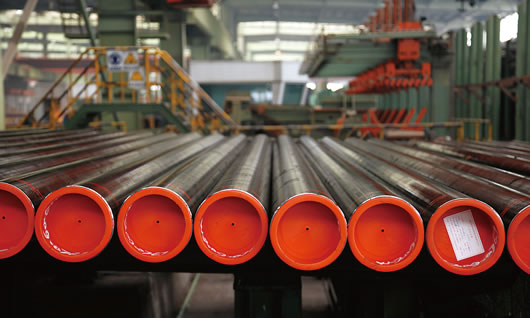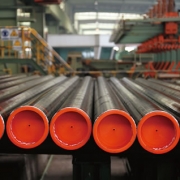Steel line pipe for oil & gas
What is Line Pipe:
Line pipe is a type of pipe that is manufactured from high strength carbon steel. It is typically made according to metallurgical specifications that were developed by the American Petroleum Institute (API). Line pipe can be used to build pipelines that transport a variety of resources including natural gas, oil, petroleum, and water. This pipe is available in a variety of diameters ranging from 2 inches to 48 inches. Line pipe can include either seamless or welded carbon steel or stainless steel piping. Because line pipe needs to withstand high pressures, there are important tests done on line pipe to ensure it meets all of the requirements of steel chemistry, strength, toughness, and dimensional characteristics. Using line pipe that meets the set criteria will ensure safe and reliable pipeline service.The size and diameter of line pipe that is required for a pipeline can vary based on the amount of gas or liquid that a pipe is intended to carry as well as the pressures that a line pipe must withstand. For example, in most cases a mainline, the principal pipeline that delivers natural gas, will require line pipe that is around 16 to 48 inches in diameter. Smaller pipelines that deliver gas to the mainline or take gas from a mainline can be constructed of 6 to 16 inch diameter line pipe. One can determine the necessary diameter required for a pipeline by considering the volume of gas or liquid that the line pipe will be carrying as well as the pressure at which this will be transported.The thickness requirements for line pipe are determined by the maximum operating pressure required for a pipeline. This is based on published standards and federal regulations. Following proper safety regulations when selecting and installing line pipe, will ensure proper pipeline operation and prevent dangerous or hazardous situations.

TYPES OF OIL & GAS PIPES
Steel pipes can be classified according to multiple criteria, such as:
Manufacturing process: seamless, erw, LSAW, DSAW, HSAW pipes
Finishing: cold rolled, hot rolled, cold finished
Materials: metal, plastic, cement, glass, fiberglass, etc and material grades (carbon steel, stainless steel, nickel alloy steel pipes)
Manufacturing norms
Line pipe sizes, grades and dimensions
Nominal pipe sizes (NPS) and diameters differ on the transported amount of gas or other flammable liquid as well as the pressures it has to withstand. The outside diameter (OD) of line tubes ranges from 1/8″ to 80″ in accordance with API 5L and other international standards (DIN, ASTM/ASME, NFA, EN) and grades (A / B / X-42 / X-46 / X-52 / X-56 / X-60 / X-65 / X-70 / X-80). Industry standards and federal regulations also specify wall thickness that is determined by the maximum operating pressure (MAOP). Further detailed information is displayed in our line pipe product chart.
standard of Steel line pipe for oil & gas
- API 5L/ISO 3183 Gr. A, B, X42, X46, X52, X56, X60, X65, X70, X80
- ASTM A134 and ASTM A135
- CSA Z245.1 Gr. 241, 290, 359, 386, 414, 448, 483, 550
Dimensional Tolerances for Line Pipes to API Specification 5L / ISO 3183
| Pipe Size | Diameter Tolerances | |||
| Pipe oxeept the end | Pipe end 1) | |||
| Mrtmir,ai Specified Outside Nominal Pipe Size Djam〇ter | seamless welded | seamless welded | ||
| Up to 2″ Up to 60.3 mm | -0.8 mm / + 0.4 mm | -0.4 mm / + 1.6 mm | ||
| , c. . . 60.3 mm up to 2 t〇6.._nd. 168.3mmjncl. | ± 0.0075 D | |||
| 6*to24*,incl. 168.3 mm up to 610 mm. incl. | +/- 0.0075 D | ±0.0075 D butmaximum of *3.2 | +/- 0.005 D. but maximum of +/-1.6 mm | |
| 26′ up to 56″, incl. 660 up to 1422 mm incl. | +/- 0.01 D | ± 0.005 D but maximum of ±4.0 | +/- 2.0 mm | +/-1.6 mm |
| Over 56* Over 1 422.0 mm | as agreed |
Pipeline System Supply delivers line pipe for onshore and offshore applications in the oil and gas industry used to convey natural gas, oil and other flammable fluids. Due to extreme conditions such as low and high temperature, high pressure and corrosive environments in the transportation of flammable media, line tubes are made from carbon, alloy or stainless steel in accordance with API 5L, EN and ISO 9001 standards. International standards determine metallurgical specifications to guarantee safe, reliable and long lasting pipelines. Therefore important tests are performed on line pipe to ensure it meets all of the determined requirements of steel chemistry, strength, toughness, and dimensional characteristics. Steel pipes can be manufactured seamless and in different welded varieties ranging from Fusion Welded (EFW), Electric Resistance Welded (ERW), High Frequency Induction (HFI) to Double Submerged Arc Welded (DSAW).



اترك رداً
تريد المشاركة في هذا النقاششارك إن أردت
Feel free to contribute!